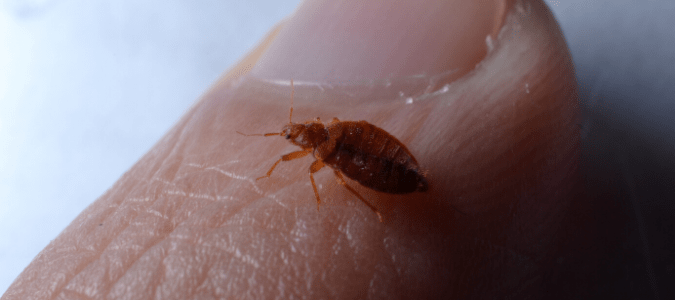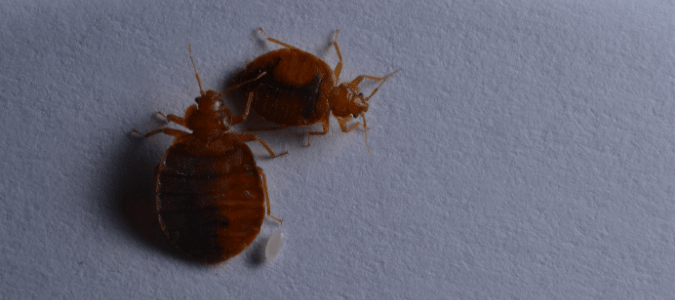Will Freezing Bed Bugs Control an Infestation?

How To Control Bed Bugs With Cold
First things first: you should know that bed bug problems can be confused with other types of pest issues. So before you try any of these techniques, you’ll want to confirm that you do have a bed bug problem. What you might assume is a bed bug problem if you have been bitten can sometimes be fleas, spiders or even mosquitoes. Bed bug bites often come in clusters of 3 to 5 and may appear on your skin in a zigzag pattern. Although you may be infested and never see an actual bed bug, signs you might have bed bugs and not another pest problem include tiny specks of dark red blood on the seams of your mattress, minuscule black dots on bedding or furniture that could be bed bug feces, shell-like exoskeletons in your living or bedroom or a musty, sweet odor.
One of the reasons bed bug infestations tend to be prolonged and why they often take a huge emotional toll on a household is that these pests are experts at hiding. And, they are so small that they are difficult to see with the untrained eye. While bed bugs do tend to be found on bedding, mattresses, cushions, furniture, they can also hide along baseboards, on headboards, nightstands and even in picture frames! So, if your home is infested, putting your bedding in the freezer unfortunately won’t do the trick.
If you do want to try using cold temperatures before reaching out to a pest control professional, you should know that freezing bed bug-infested items at zero degrees Fahrenheit or below will kill the bed bugs, but it will take time. Most standard freezers are set to 0°F, and can be set to -10° or even lower. Colder is better; the colder the temperature, the more quickly the pests will die. A good rule of thumb is to leave the items you’re freezing in the freezer for at least four days. However, the longer you can leave your items in the freezer, the better. This is because the center of the items in the freezer needs to reach 0°, and that takes time.
You should also consider what items are infested, how large your freezer is and what is safe to freeze. If you have a chest-style freezer, it’s safe to freeze things like oversized comforters, shoes, books, framed pictures or toys. You may even be able to freeze other items, but you’ll have to do your research first.
It isn’t a good idea to freeze anything that might get damaged if condensation occurs or anything that you can’t be replaced if it does get damaged. Anything that already has liquid in it also shouldn’t go in the freezer. For added protection, anything you’re going to try freezing to kill off bed bugs should be put inside a plastic bag.
How to Control Bed Bugs with Heat
Since most people don’t have much freezer space, high heat is a more practical way to kill off bed bugs. It’s also just as effective, if not more so. You can wash bed bug-infested bedding or clothes in hot water and then dry them on your dryer’s hottest setting. This should kill off any bed bugs present in the items you’re washing. Again, this tactic won’t address all the bed bugs that are hidden area in all the other parts of your home where these creatures can lie in wait until their next feeding. And unlike many other insects, a bed bug can survive for months in between feedings, which is why homeowners may think an infestation has been addressed, only to discover they still have bed bugs.
Some pest control companies have professional-grade equipment that sends hot air through your home for an extended period of time, which is a highly effective way to eliminate bed bugs throughout the home. This approach, called heat remediation, which can also be used with some other types of pest infestations, is also appealing to those who are looking for low-impact pest control solutions, as this method does not involve the use of chemicals.
If bed bugs have taken up residence in other furniture besides the bed, you can wash removable cushion covers in the same way. You’ll need to be careful about drying them, though, since some types of fabric shrink in the dryer. If your furniture has removable cushion covers but they’re the type that would shrink if dried, this method of getting rid of bed bugs may not work for you.
It’s understandable why many people look to heat and cold as ways of getting rid of bed bugs in their homes. For one, as we have mentioned, many people are wary about using chemicals themselves. Also, most bed bug control products you can purchase at the store or online aren’t very effective. Part of the reason is that experts are best equipped to know how and where to apply these spot treatments, and a pro can also advise you on a treatment schedule that fits the life cycle of these creatures.
How Do Pest Control Professionals Control Bed Bugs?
As we have already mentioned, pest control companies that specialize in treating homes for bed bugs often use high heat as a primary way of killing off bed bugs. This technique eliminates not just adult bed bugs but also their nymphs and eggs, which means it kills them at all stages of the life cycle. The way that pest management specialists use high heat in a home is also far-reaching. It penetrates the tiny spaces where bed bugs hide during the day, and where they lay their eggs.
Government agencies, including the Centers for Disease Control and the Environmental Protection Agency, recommend that people enlist professional help in getting rid of bed bugs rather than trying to tackle an infestation on their own. Certain do-it-yourself methods like freezing your bedding or washing and drying it on high heat can kill a small number of bed bugs. But, these methods only work against the bed bugs that are present in the bedding, or the ones that you can easily see. Do-it-yourself methods usually don’t work against bed bugs that are hidden in tiny spaces, or tiny eggs and nymphs. This is why professional bed bug treatments are so important in the fight against these pests. Professionals can also confirm that what you have are, in fact, bed bugs and not another type of pest.

Is It a Bed Bug, Baby Cockroach or Some Other Pest?
When you find a small, dark-colored insect in your bed—or anywhere else in your home—your heart might skip a beat. Did you just see a bed bug, baby cockroach or some other type of pest altogether? Bed bugs and baby cockroaches can look very similar, and both can resemble certain other insects like carpet beetles. They do have distinct differences, though, which can help you identify which one you’re dealing with.
Bed bugs and baby cockroaches are a similar size and color—medium to dark brown, and only a few millimeters across. Adult bed bugs, as you can see in the image above, might reach a quarter-inch in length, while cockroaches grow much larger than that. Young cockroaches can be anywhere from an eighth of an inch to a half-inch long, or longer. Bed bugs and cockroaches also both have six legs and two antennae each. Still, there are differences between them.
Identification Tips
If you’ve found insects in your bed or anywhere else in your home and you’re wondering if they are bed bugs or baby cockroaches, here are some identifying characteristics to look for:
- Are their antennae straight or curved? Bed bugs have tiny antennae that are a bit curved or even bent, while cockroaches’ antennae are longer, thinner and perfectly straight.
- Are their bodies wide or narrow? Bed bugs are oval-shaped and nearly as wide as they are long, while cockroach bodies are narrower.
- Do they have what looks like a tiny tail? If so, it’s more likely to be a cockroach; these insects have two little tail-like extensions that come out of the ends of their bodies.
- How quickly do they move? If you’ve found a live insect and it moves quickly, it’s more likely to be a cockroach. Bed bugs can also move relatively quickly, but it’s rarer to find a living bed bug during daylight hours, and cockroaches are known for their speed.
Figuring out what type of insect is in your home is important. Different pests require different pest control products and techniques. Even figuring out if you have German or American cockroaches could mean a difference in treatment methods. This is why many people wind up contacting a pest management professional to inspect their homes and deal with the problem. Professionals can make an accurate diagnosis of what type of pest has invaded your home, and they are trained in all types of pests’ biology and management. They know the most effective ways to get rid of any type of pest.
With all the talk of eliminating these pests throughout their life cycle, you may be wondering how long it takes for bed bug eggs to hatch into nymphs.

How Long Do Bed Bug Eggs Take to Hatch?
How long do bed bug eggs take to hatch? It’s a question people often ask pest control specialists. The short answer is that it usually takes about a week, more or less, and up to ten days for bed bug eggs to hatch. When bed bugs mate, the females lay their eggs in small crevices. For example, bed bug eggs are often found along the piping that runs down the edges of many types of mattresses. These eggs are so small that they are very difficult to see with the naked eye. They also might lay eggs in the cracks between floorboards below the bed, or between baseboards and the wall. Then it takes about six to ten days for the eggs to hatch.
As soon as the eggs hatch into baby bed bugs, called nymphs, they need a blood meal to grow. The nymphs will feed and then shed their skins, or exoskeletons, five times before becoming full-grown adult bed bugs. Once they are adults, they can mate and lay more bed bug eggs.
A single female bed bug can lay hundreds of eggs over the course of her lifetime. This is why bed bug infestations can grow so quickly, becoming really difficult to control. People who try do-it-yourself methods of getting rid of bed bugs in their homes often just make the problem worse. This is because their methods either don’t work or don’t reach all the bed bugs in all the stages of their life cycle.
What Can I Do To Control These Pests?
It’s not enough just to kill off the adult bed bugs, or the nymphs and adults that are biting you while you sleep. It’s also not enough just to kill the bed bugs that you can see, as these pests aren’t often out during the daytime hours, and bed bugs are incredibly good at hiding. Any bed bug treatment has to be multi-pronged, using multiple techniques to ensure that even the hidden bed bugs are killed off.
One green tip to help get rid of bed bugs is to clean your home thoroughly. You can wash and dry your bedding regularly on high heat, and vacuum your home thoroughly to get rid of as many bed bugs as possible. Vacuum carefully along the edges and seams of mattresses and other furniture, and also along the floor and the baseboards around your bed. Bed bugs have also been known to hide behind pictures or wall hangings, or even in dresser drawers, so these are important places to look as well. That said, bed bugs can infest even the cleanest of homes, so unfortunately this practice will not guarantee you’ll never have a problem.
While some methods will help a lot in getting rid of a small number of bed bugs, they work best when they are used in conjunction with a professional bed bug treatment. A professional can create a plan to treat the entire house, including the tiny, invisible places where bed bugs hide.
Chem-free Can Eliminate the Bed Bugs in Your Home
Dealing with a bed bug problem can be overwhelming for a number of reasons. For pest control with baby safety in mind, or to protect your furry family members, contact Chem-free. We use heat treatment to eliminate bed bugs at all stages of their life, so you and your family members can have some relief.
Need Help Managing Pests?
Chem-Free offers both effective, low-impact pest control options and preventative measures to help avoid future infestations. Contact us today for a free estimate!


